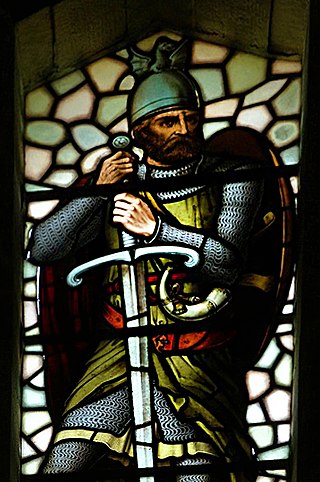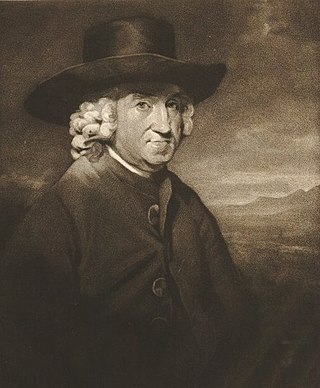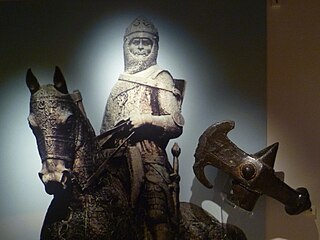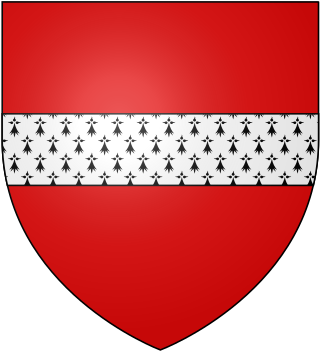
Sir William Wallace was a Scottish knight who became one of the main leaders during the First War of Scottish Independence.

Blind Harry, also known as Harry, Hary or Henry the Minstrel, is renowned as the author of The Actes and Deidis of the Illustre and Vallyeant Campioun Schir William Wallace, more commonly known as The Wallace. This was a lengthy poem recounting the life of William Wallace, the Scottish independence leader, written around 1477, 172 years after Wallace's death.

Allan Ramsay was a Scottish poet, playwright, publisher, librarian and impresario of early Enlightenment Edinburgh.

Robert Fergusson was a Scottish poet. After formal education at the University of St Andrews, Fergusson led a bohemian life in Edinburgh, the city of his birth, then at the height of intellectual and cultural ferment as part of the Scottish enlightenment. Many of his extant poems were printed from 1771 onwards in Walter Ruddiman's Weekly Magazine, and a collected works was first published early in 1773. Despite a short life, his career was highly influential, especially through its impact on Robert Burns. He wrote both Scottish English and the Scots language, and it is his vivid and masterly writing in the latter leid for which he is principally acclaimed.

John Jamieson DD was a Scottish minister of religion, lexicographer, philologist and antiquary. His most important work is the Dictionary of the Scottish Language.

David Laing LLD was a Scottish antiquary.
William Hamilton was a Scottish poet. He wrote comic, mock-tragic poetry such as "The Last Dying Words of Bonny Heck" - a once-champion hare coursing greyhound in the East Neuk of Fife who was about to be hanged, for growing too slow. It is written in anglified Scots, with a sprightly narrative and wry comic touches.

William Tytler WS FRSE (1711–1792) was a Scottish lawyer, known as a historical writer. He wrote An Inquiry into the Evidence against Mary Queen of Scots, against the views of William Robertson. He discovered the manuscript the "Kingis Quhair", a poem of James I of Scotland. In 1783 he was one of the joint founders of the Royal Society of Edinburgh.

A makar is a term from Scottish literature for a poet or bard, often thought of as a royal court poet.
Sir James Melville (1535–1617) was a Scottish diplomat and memoir writer, and father of the poet Elizabeth Melville.
Sir William Crawford is a character in The Wallace, Blind Harry's epic poem about William Wallace. He appears to be an unhistorical character, although there was a Crawford family in Ayrshire at the time of the Wars of Scottish Independence, some of whom may have been Sheriff of Ayrshire.

New Cumnock is a town in East Ayrshire, Scotland. It expanded during the coal-mining era from the late 18th century, and mining remained its key industry until its pits were shut in the 1960s. The town is 5+3⁄4 miles southeast of Cumnock, and 21 miles east of Ayr.

The Brus, also known as The Bruce, is a long narrative poem, in Early Scots, of just under 14,000 octosyllabic lines composed by John Barbour which gives a historic and chivalric account of the actions of Robert the Bruce and Sir James Douglas in the Scottish Wars of Independence during a period from the circumstances leading up to the English invasion of 1296 through to Scotland's restored position in the years between the Treaty of 1328 and the death of Thomas Randolph, Earl of Moray in 1332.
The Eneados is a translation into Middle Scots of Virgil's Latin Aeneid, completed by the poet and clergyman Gavin Douglas in 1513.
William Stewart was a Scottish poet working in the first half of the 16th century.

Sir Reginald Crawford was a Scottish knight who took part in the Wars of Scottish Independence.
The Barns of Ayr was, according to Blind Harry in The Wallace, a site in Ayr, Scotland, which was used as English barracks. According to Blind Harry, a number of Scottish barons of Ayrshire were called to a meeting with King Edward I of England at a barn used as an English military barracks, only to be massacred and hanged, including Sir Ronald Crawford Sheriff of Ayr, Sir Bryce Blair of Blair, Sir Neil Montgomerie of Cassillis, Crystal of Seton, and Sir Hugh Montgomerie. In revenge, William Wallace burned the barracks with the English inside.
The Scottish Text Society (STS) is a text publication society founded in 1882 to promote the study of Scottish literature. The Society publishes scholarly editions of important texts from the country's literary history, and has played a significant role in the revival of interest in the literature and languages of Scotland.

Poetry of Scotland includes all forms of verse written in Brythonic, Latin, Scottish Gaelic, Scots, French, English and Esperanto and any language in which poetry has been written within the boundaries of modern Scotland, or by Scottish people.

Scots-language literature is literature, including poetry, prose and drama, written in the Scots language in its many forms and derivatives. Middle Scots became the dominant language of Scotland in the late Middle Ages. The first surviving major text in Scots literature is John Barbour's Brus (1375). Some ballads may date back to the thirteenth century, but were not recorded until the eighteenth century. In the early fifteenth century Scots historical works included Andrew of Wyntoun's verse Orygynale Cronykil of Scotland and Blind Harry's The Wallace. Much Middle Scots literature was produced by makars, poets with links to the royal court, which included James I, who wrote the extended poem The Kingis Quair. Writers such as William Dunbar, Robert Henryson, Walter Kennedy and Gavin Douglas have been seen as creating a golden age in Scottish poetry. In the late fifteenth century, Scots prose also began to develop as a genre. The first complete surviving work is John Ireland's The Meroure of Wyssdome (1490). There were also prose translations of French books of chivalry that survive from the 1450s. The landmark work in the reign of James IV was Gavin Douglas's version of Virgil's Aeneid.













